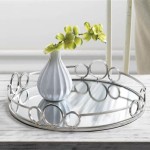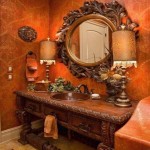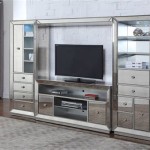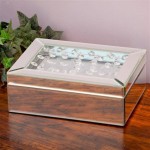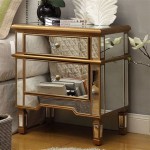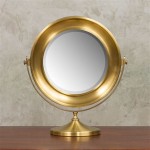How to Steam Proof a Mirror
A mirror can be a beautiful addition to any room, but it can also be a source of frustration when it comes to steam. Steam from showers, baths, and even cooking can cause condensation on the mirror, making it difficult to see. This can be especially problematic in bathrooms and kitchens. Fortunately, there are a number of ways to steam proof a mirror, making it less susceptible to condensation.
1. Use a Steam-Proofing Spray
One of the simplest and most effective ways to steam proof a mirror is to use a commercially available steam-proofing spray. These sprays create a thin, invisible coating on the mirror's surface that repels water droplets. They are typically easy to apply and can last for several weeks or even months. To apply a steam-proofing spray, simply follow the instructions on the product's label. Generally, you will spray the mirror evenly with the product, allow it to dry completely, and then wipe it clean with a soft microfiber cloth. Remember to apply the product to the entire surface area of the mirror, including the edges.
2. Apply a Thin Layer of Soap
Another easy and inexpensive way to steam proof a mirror is to apply a thin layer of soap. This method works by creating a barrier between the mirror and the steam. To apply soap to a mirror, simply wet a soft cloth with water and then apply a thin layer of liquid soap to the mirror's surface. Use a circular motion to ensure that the soap is evenly distributed. Wipe away any excess soap and allow the mirror to dry completely. Reapply soap as needed, which may be more frequent than using a steam-proofing spray.
3. Create a DIY Steam-Proofing Solution
If you don't want to use a commercial product, you can create your own steam-proofing solution. One popular DIY solution is made with equal parts white vinegar and water. To create this solution, simply mix equal parts white vinegar and water in a spray bottle. Apply the solution to the mirror in the same way you would apply a commercial steam-proofing spray. Allow the solution to dry completely and then wipe the mirror clean with a soft microfiber cloth. This solution works because the vinegar helps to break down the water molecules, preventing them from forming condensation on the mirror's surface. However, note that vinegar has a pungent smell, so be sure to air out the room after applying this solution.
4. Use a Dehumidifier
If you live in a humid climate or have a lot of steam in your bathroom, you may find that a dehumidifier is helpful. Dehumidifiers work by removing moisture from the air, which can help to prevent condensation from forming on mirrors. If you choose to use a dehumidifier, be sure to place it in a location that is well-ventilated and away from any heat sources. Dehumidifiers are most effective when used in conjunction with other steam-proofing methods. They work best in small bathroom spaces.
5. Install a Bathroom Fan
A bathroom fan can help to remove steam and moisture from the air, which can help to prevent condensation from forming on mirrors. If you don't have a bathroom fan, consider having one installed. When using a bathroom fan, be sure to run it for at least 15 minutes after a shower or bath to remove as much moisture from the air as possible. It is also a good idea to leave the bathroom door open for a few minutes after a shower or bath to allow fresh air to circulate. This can be especially helpful when using a dehumidifier as well.
6. Consider the Mirror's Material
Some mirrors are more susceptible to condensation than others. For example, mirrors with a silver backing are more likely to fog up than mirrors with copper or aluminum backings. Mirrors with a clear protective coating on the front surface are also less likely to fog up than mirrors without this coating. If you are buying a new mirror, consider these factors to help you choose a mirror that is less likely to steam up. Furthermore, metal framed mirrors are often better at resisting condensation than mirrors with wooden frames, as metal frames can more readily conduct heat away from the mirror's surface.
7. Use a Squeegee
If you find that your mirror is still fogging up, you can use a squeegee to wipe away the condensation. This is a simple and effective way to keep your mirror clear. After you shower or bath, simply wipe the mirror down with a squeegee to remove any condensation. If you don't have a squeegee, you can use a microfiber cloth to wipe away the condensation, but be sure to dry the mirror thoroughly after cleaning. You can use a soft microfiber cloth for this, or a dedicated squeegee, which is specifically designed for this purpose.

3 Ways To Keep Mirrors From Fogging Up With Steam

3 Ways To Keep Mirrors From Fogging Up With Steam

3 Ways To Keep Mirrors From Fogging Up With Steam

3 Ways To Keep Mirrors From Fogging Up With Steam

Steam Proof Mirror Bathroom Lighted

3 Ways To Keep Mirrors From Fogging Up With Steam

How To Stop Foggy Mirrors In The Bathroom Steam Proof Your Mirror Free Make Shower

7 Easy Ways To Stop A Bathroom Mirror From Steaming Up City

Easy Ways To Stop A Bathroom Mirror From Steaming Up Cleanipedia Za

5 Simple Ways To Keep Your Bathroom Mirror From Fogging Up Housekeeping Wonderhowto


